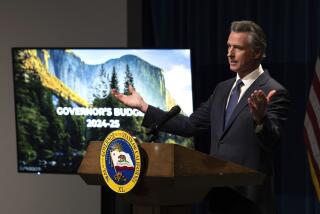Flu Preparedness Would Make State a Leader
Gov. Arnold Schwarzenegger’s proposed $400-million investment in pandemic flu and disaster preparedness -- by far the largest amount any state has devoted to the cause -- would vault California from a laggard to a national leader in one stroke, healthcare experts said Friday.
“This is the first state in the nation taking these kinds of steps,” said Dr. Jack Lewin, chief executive of the California Medical Assn. “I think it will almost be a message to the governors in every other state that they need to do something similar.”
For the record:
12:00 a.m. May 17, 2006 For The Record
Los Angeles Times Wednesday May 17, 2006 Home Edition Main News Part A Page 2 National Desk 2 inches; 71 words Type of Material: Correction
Bird flu preparations: An article in Saturday’s Section A about Gov. Arnold Schwarzenegger’s plan to invest $400 million in pandemic flu and disaster preparedness quoted Sandra Shewry, director of the Department of Health Services, as saying, “Gov. Schwarzenegger thinks it would be wrong to game with the health of 37 million Californians.” She actually said the governor believes “it would be wrong to gamble with the health of 37 million Californians.”
The association and other healthcare experts had previously argued that California was ill-prepared to handle waves of patients that could overwhelm hospitals and health workers in a flu disaster. Trust for America’s Health, a nonpartisan nonprofit, last year ranked California’s preparedness for public health emergencies below those of Oklahoma, Louisiana and Tennessee.
The proposal, announced Friday as part of Schwarzenegger’s revised budget, would make enormous strides toward preparing the state not just for a flu pandemic, but for any major disaster, including earthquakes, floods, tsunamis or bioterrorist attacks.
Provisions in the governor’s plan, which is subject to two-thirds approval by the Legislature, include:
* Buying nearly 7,200 ventilators, at a cost of nearly $100 million -- almost double the number the federal government is to purchase for the entire nation.
* Allocating $164 million to help hospitals open and supply equipment for tens of thousands of extra beds in an emergency.
* Paying $53 million for nearly 3.7 million doses of anti-flu drugs, $50 million for protective respiratory masks and $12 million for two tent-like mobile hospitals -- complete with operating rooms, intensive-care units and isolation wards -- that each could handle 200 patients.
Sandra Shewry, director of the Department of Health Services, acknowledged that the cost of the plan was significant, but that it was as essential as repairing and fortifying levees in the Sacramento River Delta.
“If we don’t begin to prepare now ... we will not have been prepared as we should have been,” Shewry said. “Gov. Schwarzenegger thinks it would be wrong to game with the health of 37 million Californians.”
“To do anything less would be absolutely irresponsible,” Schwarzenegger said at a news conference.
Shewry said health officials came up with the proposal after reviewing results from California’s first comprehensive survey of hospital resources, and comparing the gaps to federal guidelines of what the state needs.
They found that California has 72,000 licensed and staffed hospital beds, and could find an additional 17,300 in an emergency. But a pandemic flu would require as many as 130,700 beds at its peak.
Officials also found that the number of ventilators the state had was woefully inadequate -- only 7,183, yet the state would need about 34,000 in a pandemic. The additional purchase would not entirely cover the state’s needs, but it would double the state’s supply, Shewry said.
Schwarzenegger’s proposed allocation dwarfs the money other states have dedicated to pandemic flu preparations.
By comparison, New York Gov. George Pataki set aside $29 million in this year’s budget for surgical masks, anti-flu medicine and ventilators. Massachusetts Gov. Mitt Romney has proposed $36.5 million to identify additional hospital beds, upgrade labs and to stockpile medicine and supplies.
Scientists are concerned that a flu virus that has recently killed millions of birds and more than 100 people, mostly in Asia, might mutate into a form that could easily spread among humans. In the last century, a flu pandemic has struck three times, in 1918, 1957 and 1968.
A pandemic, by definition, would sicken about one-third of the population. In the worst case, 1.9 million Americans -- including 35,000 Californians -- could die, according to the state and federal governments.
Disaster experts and physicians were particularly pleased with the money devoted to so-called surge capacity, enabling hospitals to handle a flood of patients in an emergency.
“The emphasis on hospital surge is absolutely the right priority, and it’s the one that’s been neglected by the federal government,” said Kim Elliott, deputy director at Trust for America’s Health, which urged greater emergency preparedness last year.
In addition, Shewry said, officials are going to draft regulations to require hospitals to have a surge capacity plan as a condition for licensure, just as hospitals are required to have an evacuation plan.
She described surge capacity planning in California as “very rudimentary” until now.
The purchase of anti-flu medication, including Tamiflu and Relenza, is to meet federal guidelines to stockpile enough treatments to cover one-fourth of the state’s population. In addition to the state’s contribution, the federal government has pledged more than 5 million doses from its planned stockpile for California.
Across California, local public health officials -- and former critics -- praised the proposal.
“What’s exciting about this is in the healthcare field we are generally reacting to disasters,” said Carol Meyer, director of Los Angeles County’s Emergency Medical Services Agency. “In this particular situation, the state is stepping up to the plate and is being proactive.”
“It shows incredible foresight to the potential devastation of a pandemic flu outbreak or other major health emergency,” Elliott said.
The budget proposal was met with some praise among legislators, including Sen. Deborah Ortiz (D-Sacramento), chairwoman of the health committee. “We’re comparable to the fifth-largest economy in the world and we have a public health system that ranks below ... Louisiana,” Ortiz said, referring to the Trust for America’s Health survey. “The governor’s proposal ... could be a huge, huge step in changing that and moving us forward.”
But others said the burden was on Schwarzenegger to prove that the $400 million was necessary.
“We just want to make sure that $400 million doesn’t go into a black hole where it doesn’t really protect people,” said Sen. George Runner (R-Lancaster), the ranking Republican on the health committee. “It’s going to be the governor’s role to come forward now with why it is he believes these dollars need to be spent that way.”
Times staff writer Evan Halper contributed to this report.
*
The plan
Gov. Arnold Schwarzenegger has proposed spending $400 million to increase the state’s preparedness. Where some of the money will go:
$164 million: For equipment to supply additional hospital beds in an emergency
$100 million: 7,183 ventilators, devices that aid breathing
$53 million: 3.7 million courses of antiviral medication
$50 million: 101 million special respirator masks for healthcare workers
$14.5 million: For hospitals to develop “surge capacity” plans for handling an influx of patients
$12 million: Two tent-based mobile hospitals with 200 beds each
Source: California Department of Health Services
More to Read
Sign up for Essential California
The most important California stories and recommendations in your inbox every morning.
You may occasionally receive promotional content from the Los Angeles Times.











